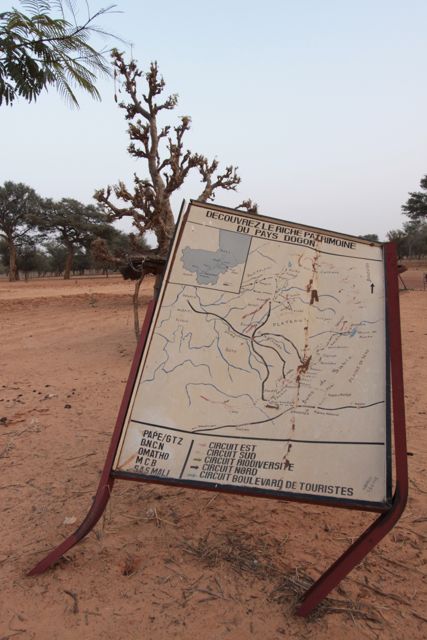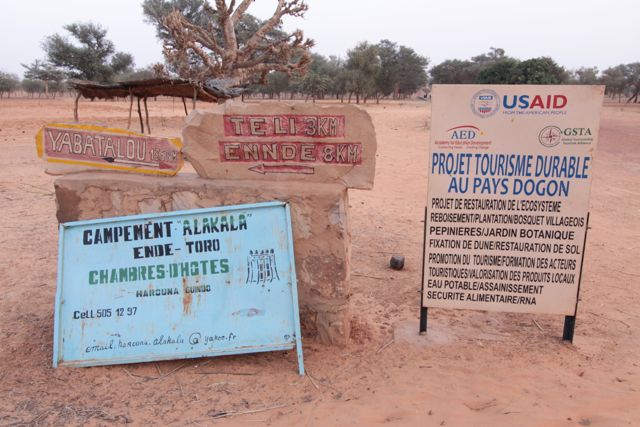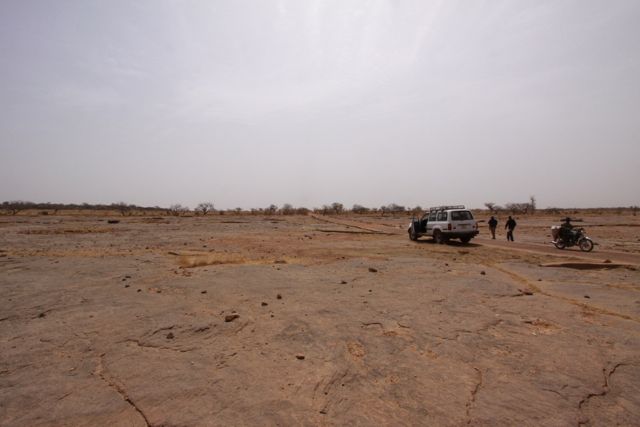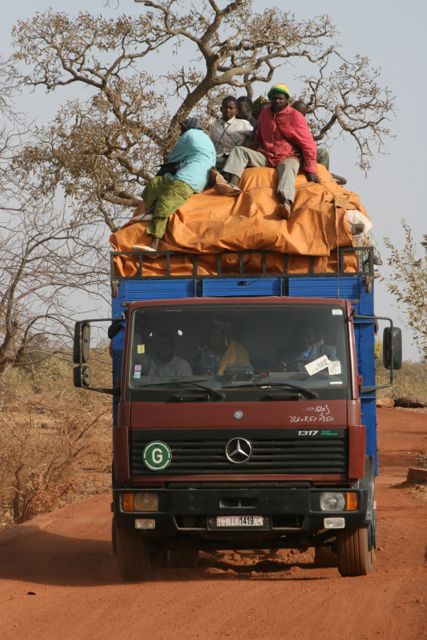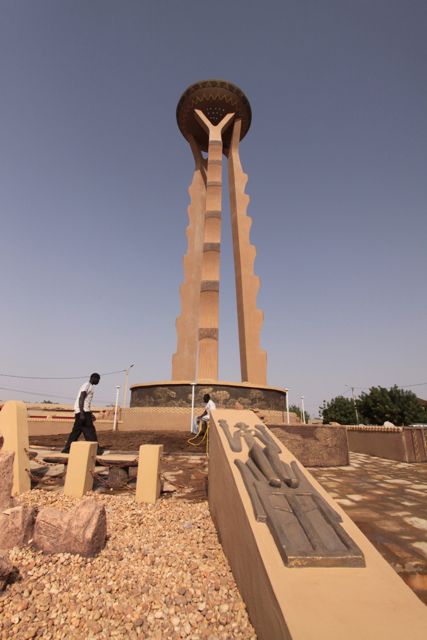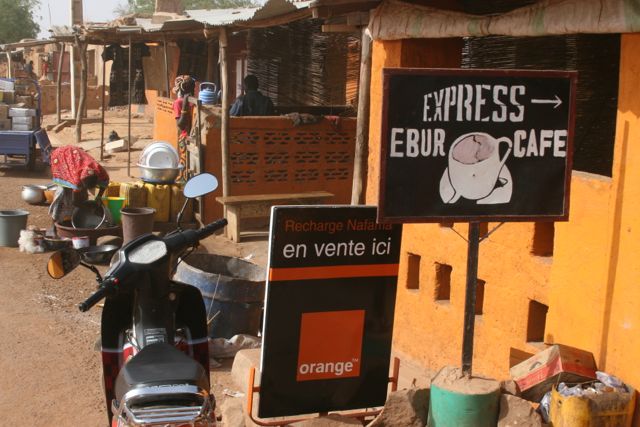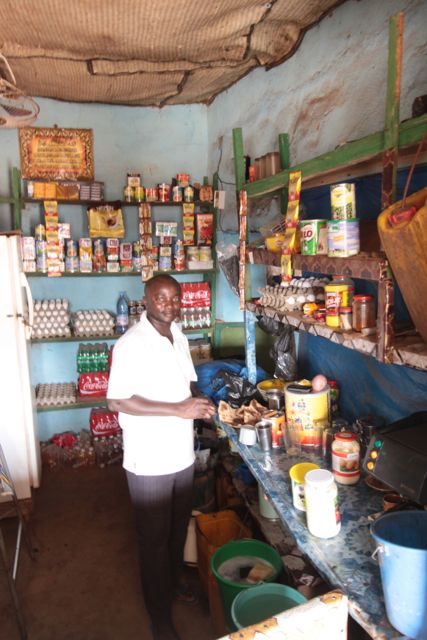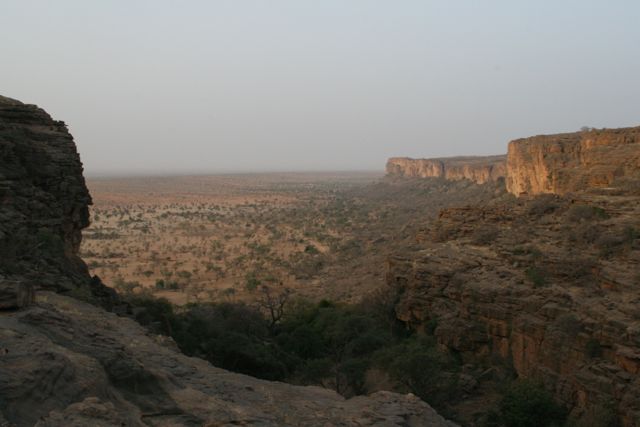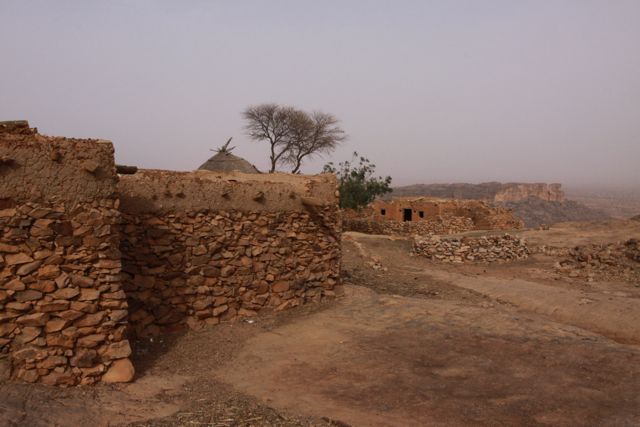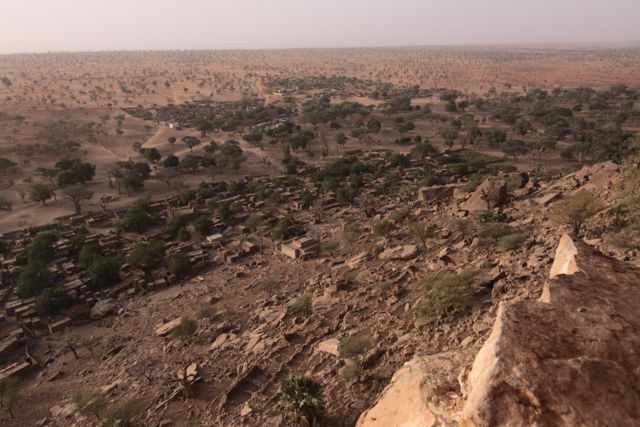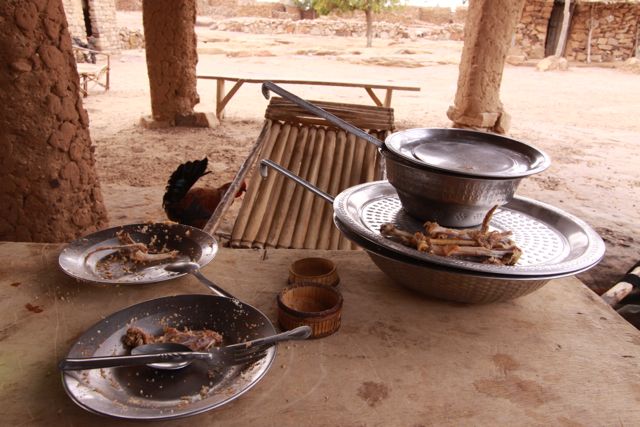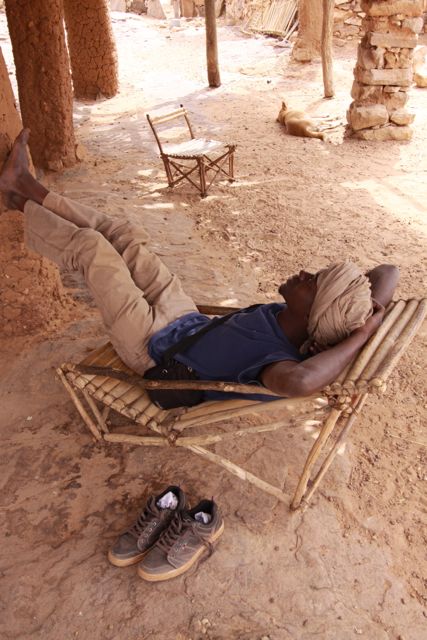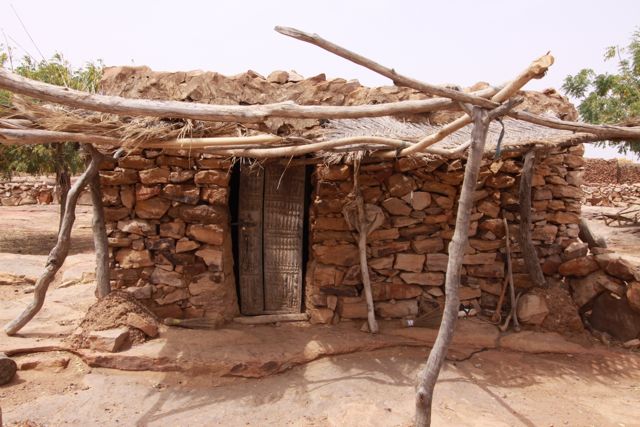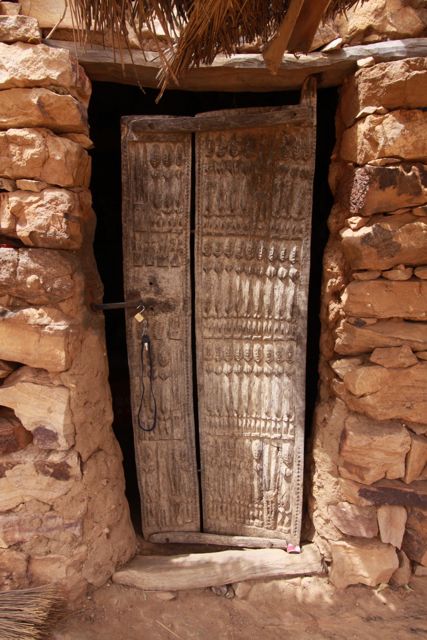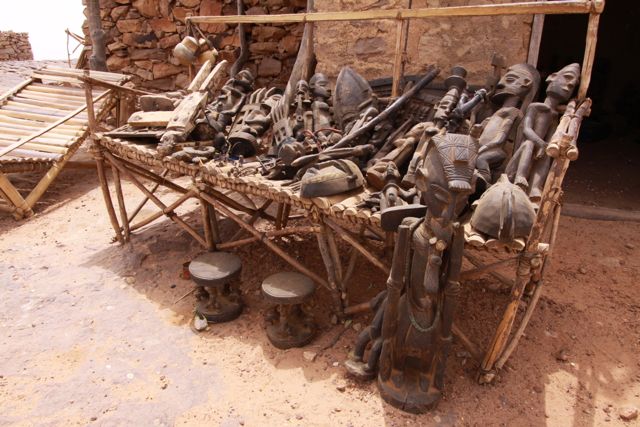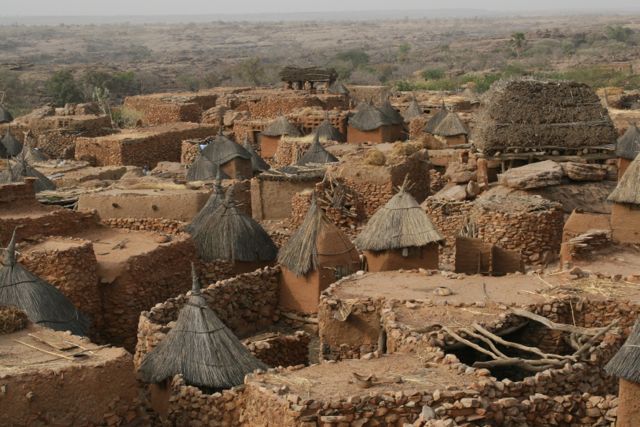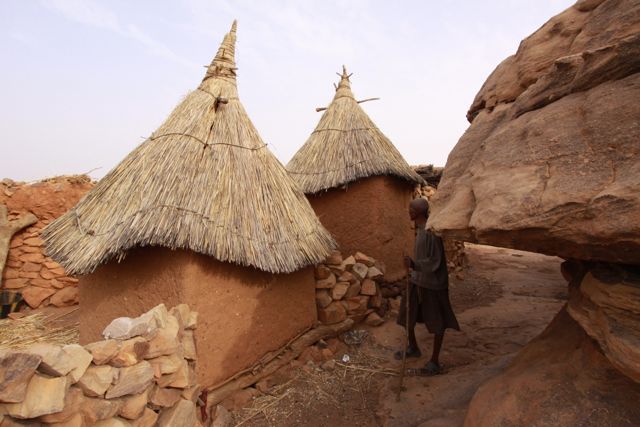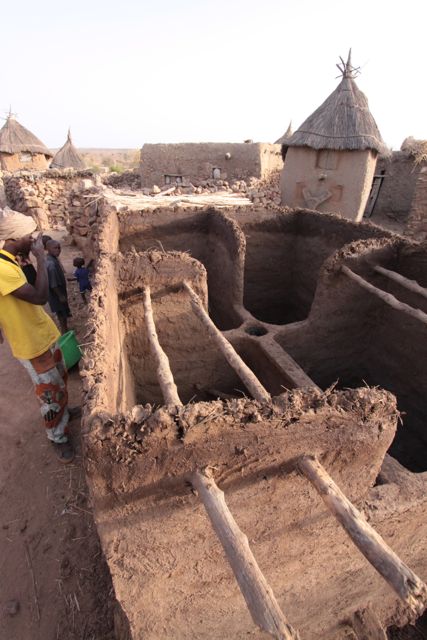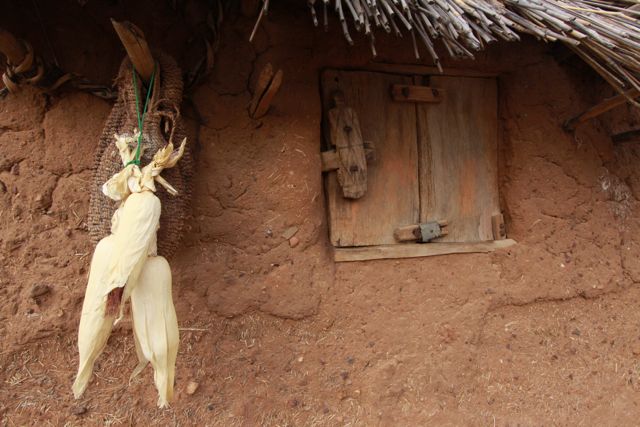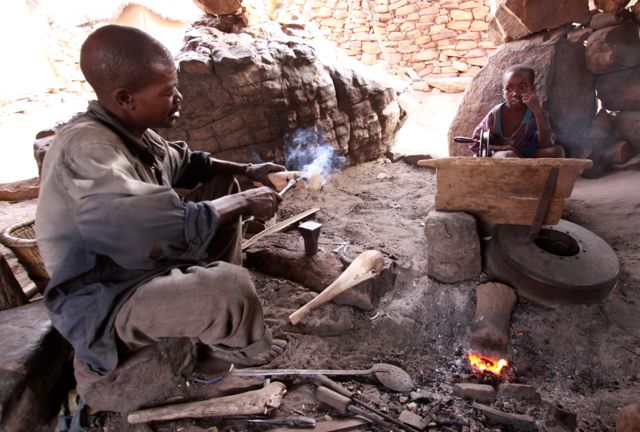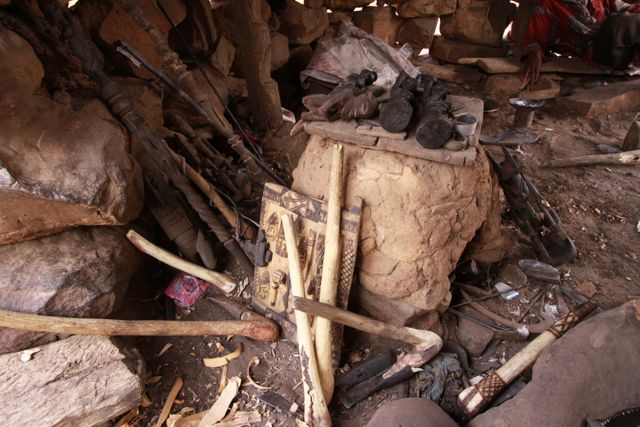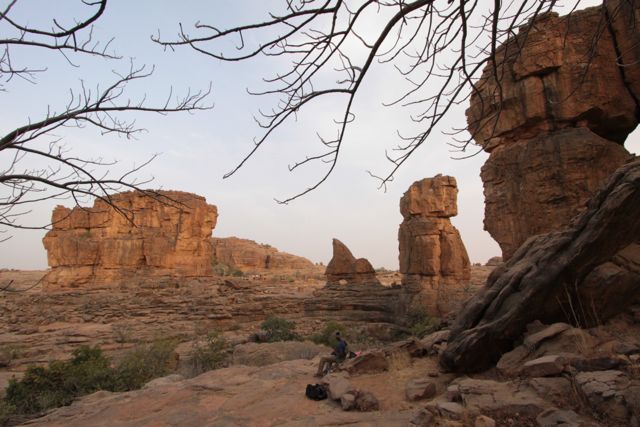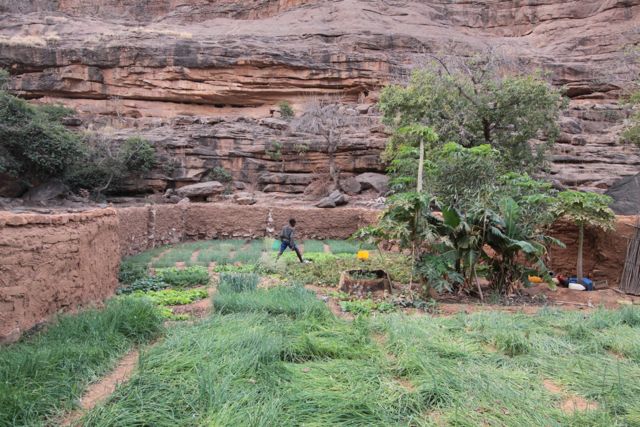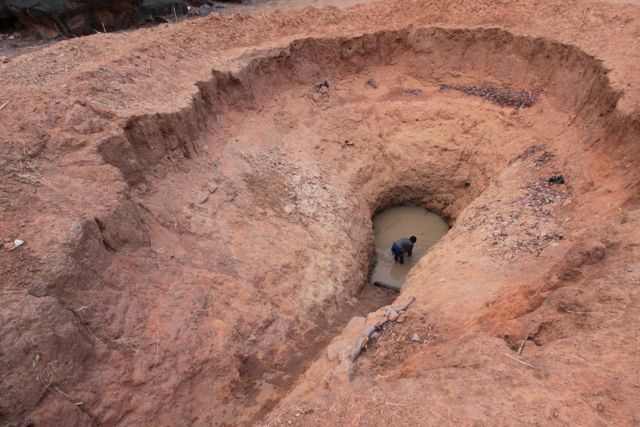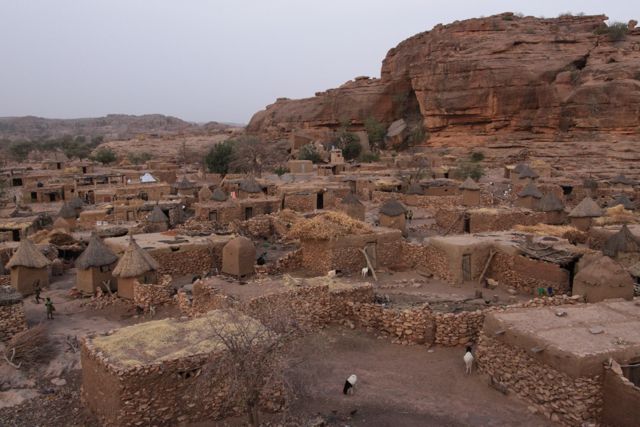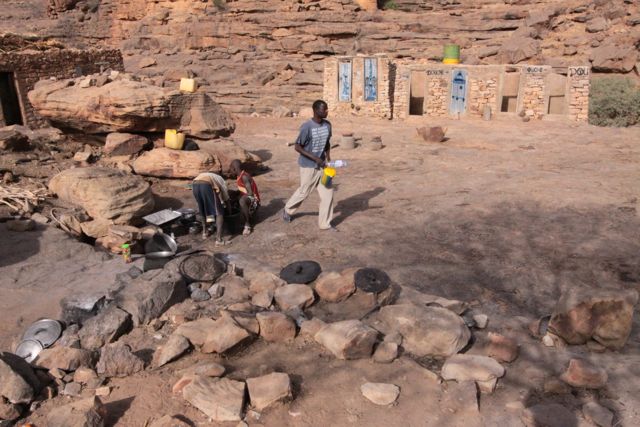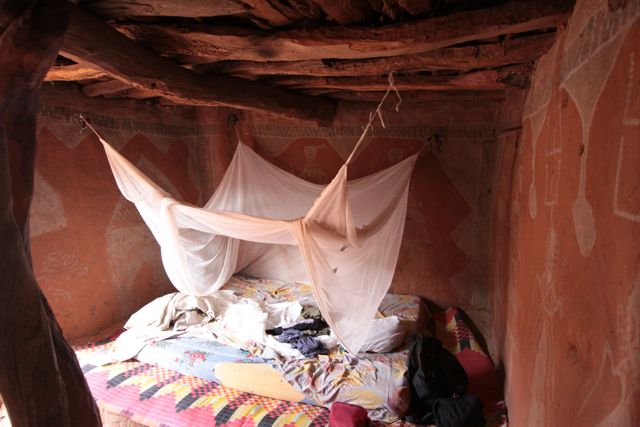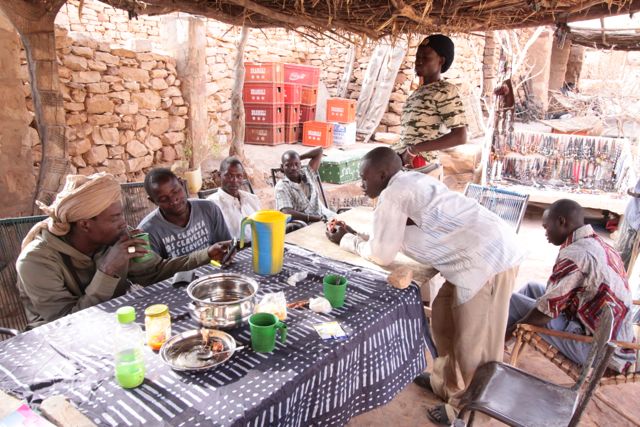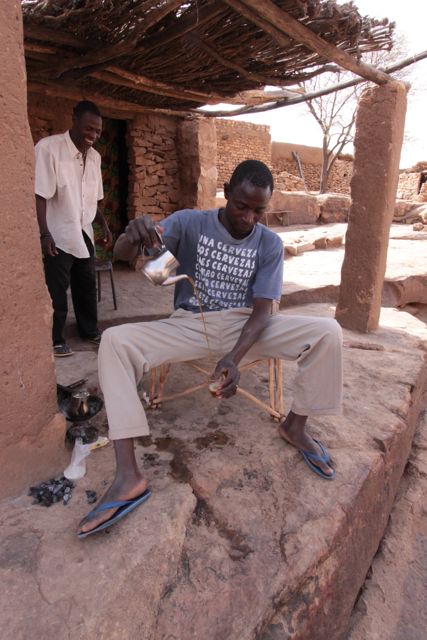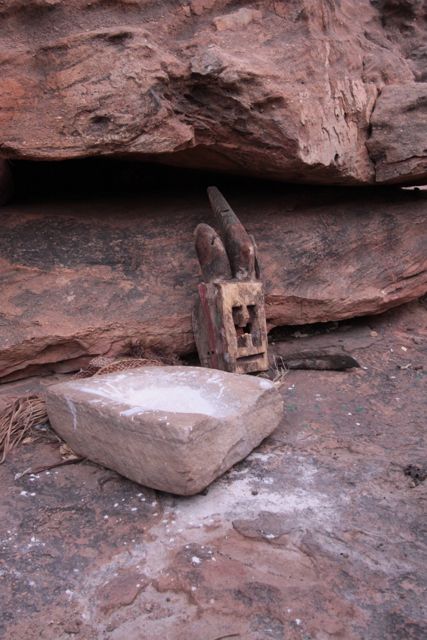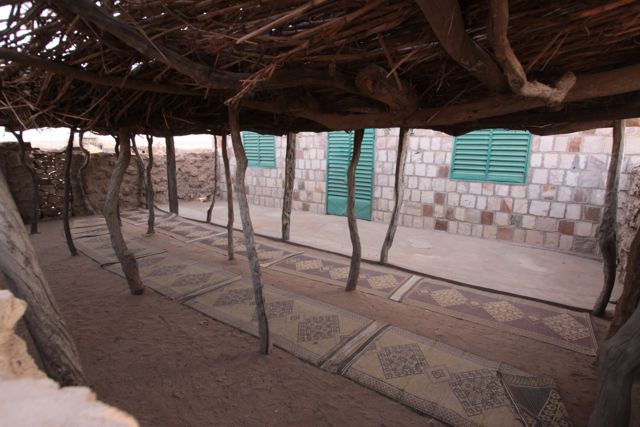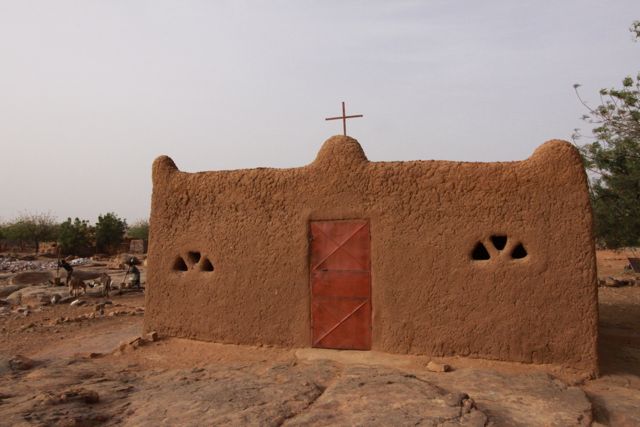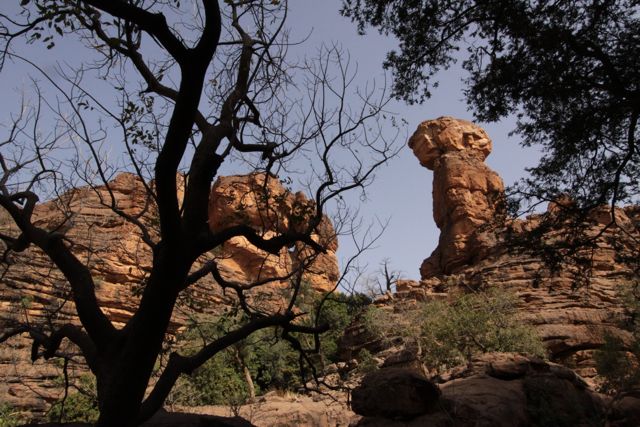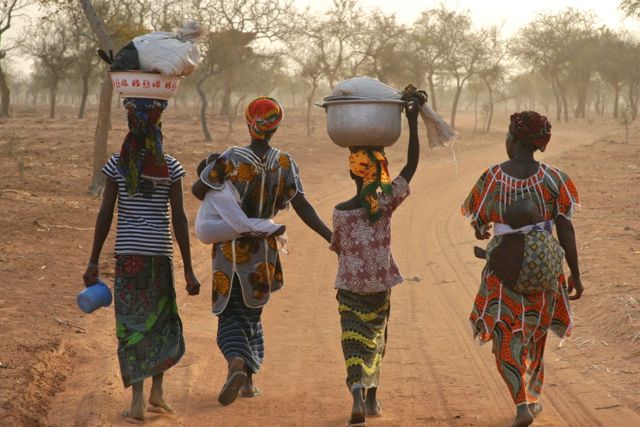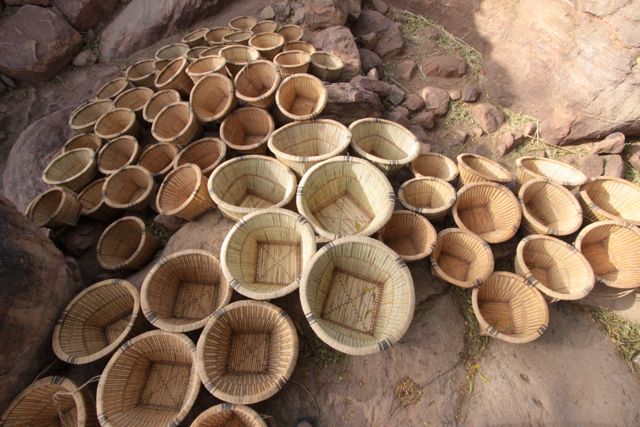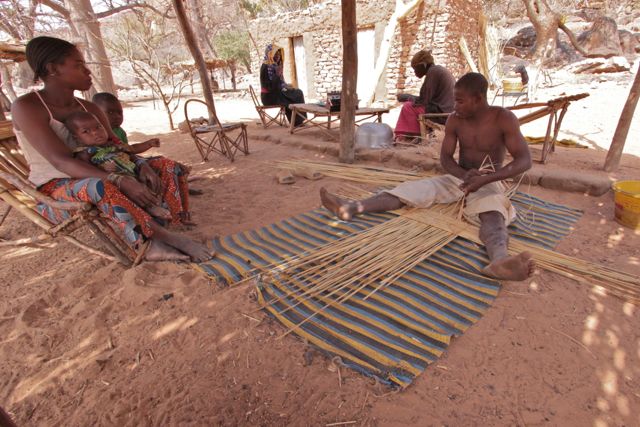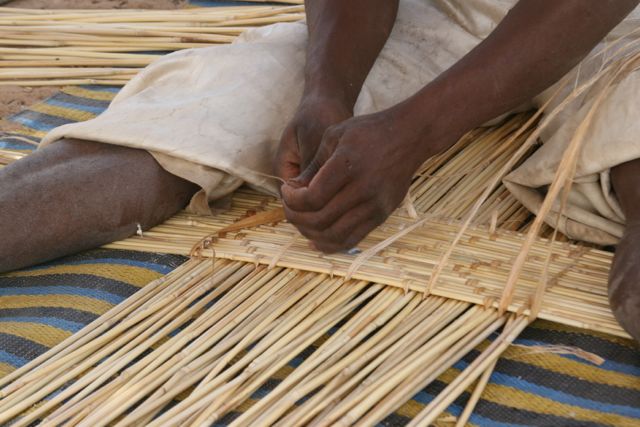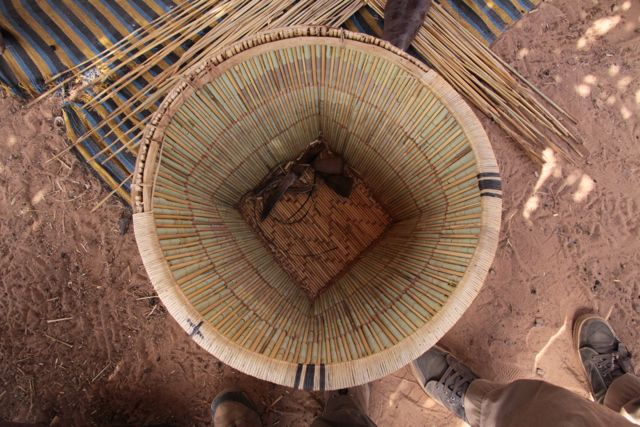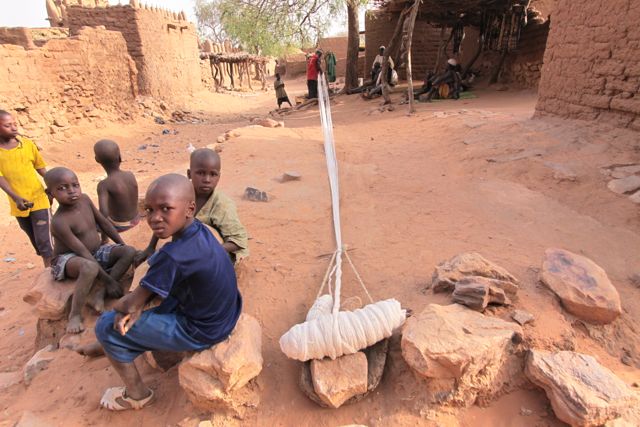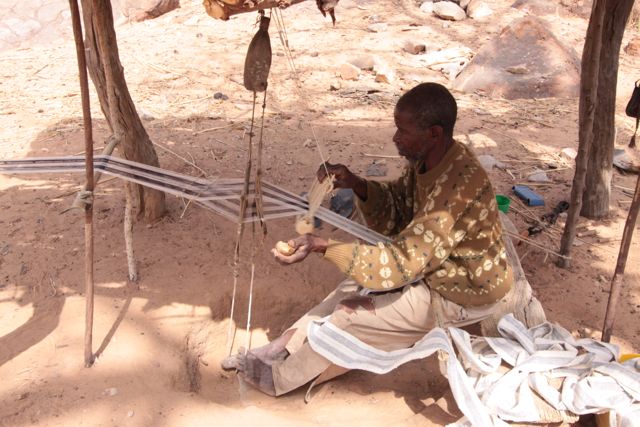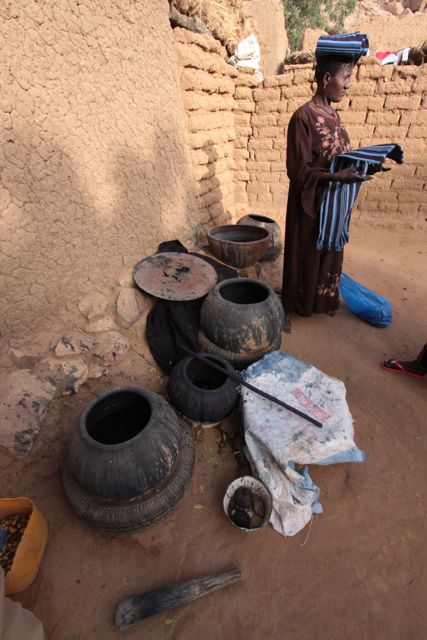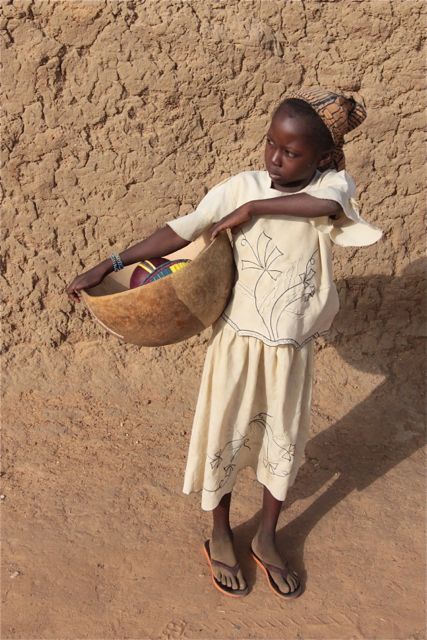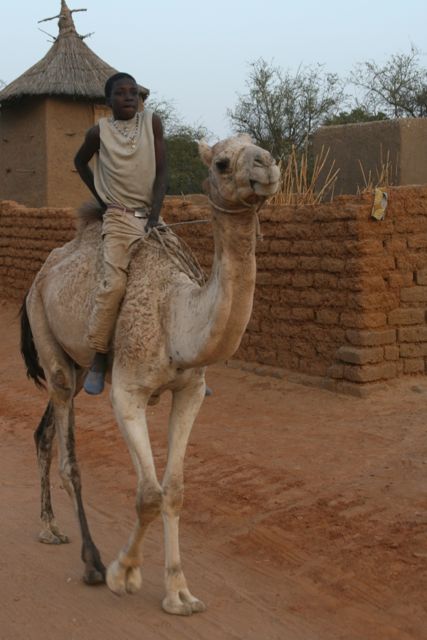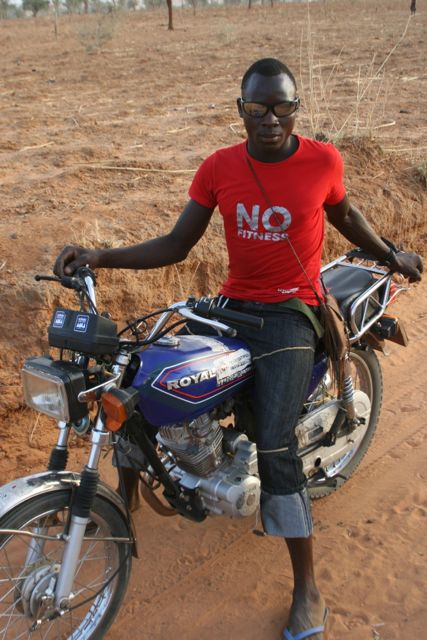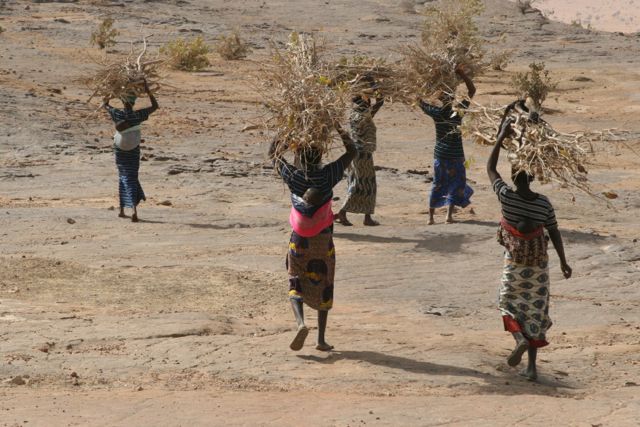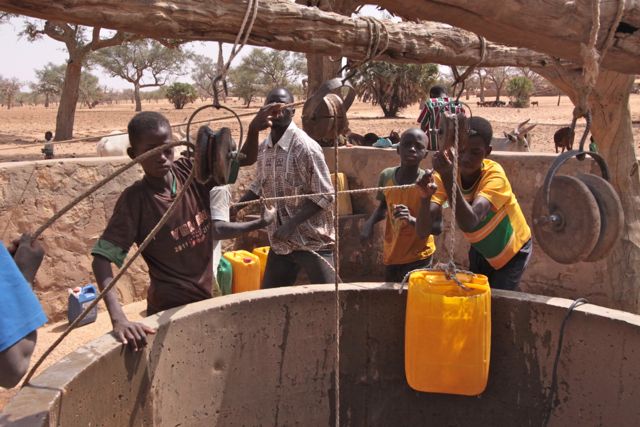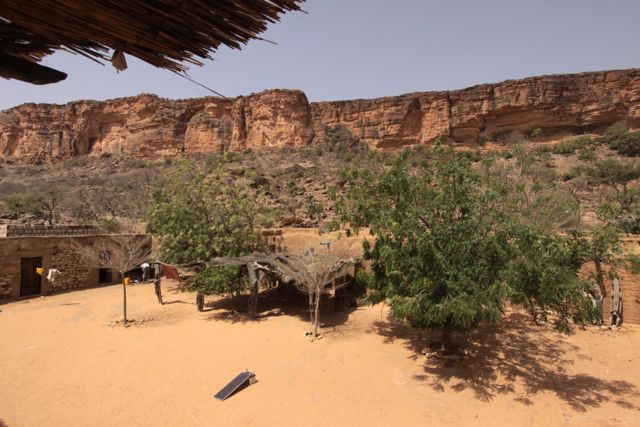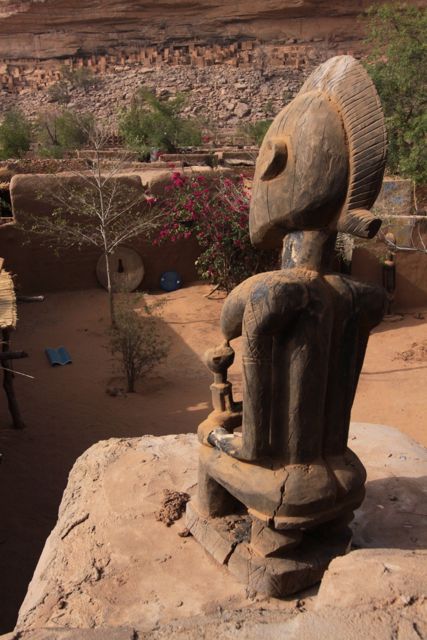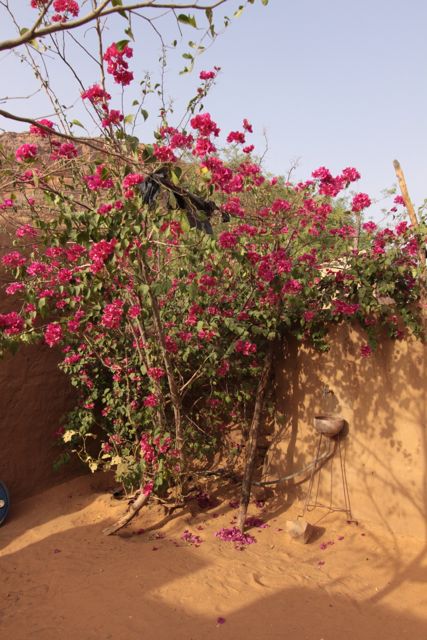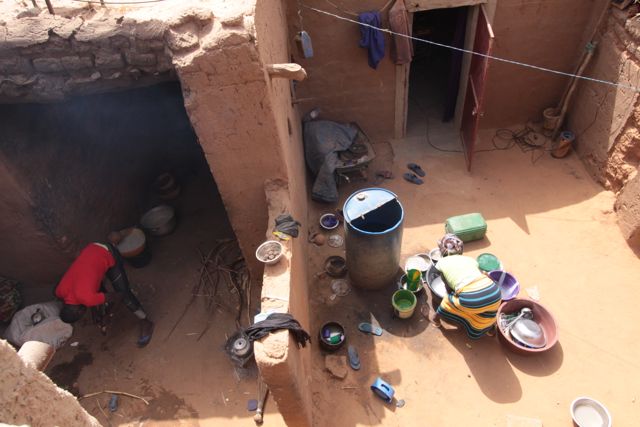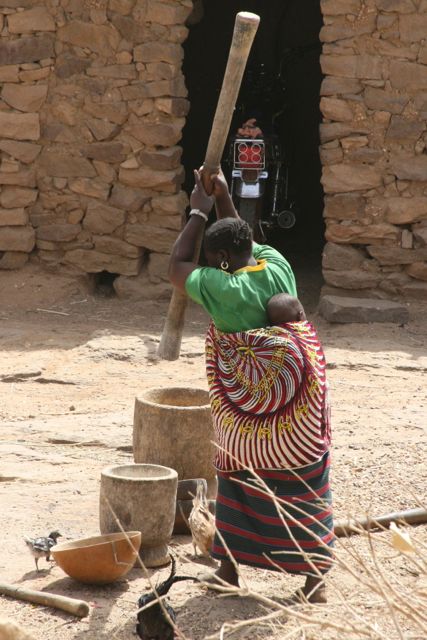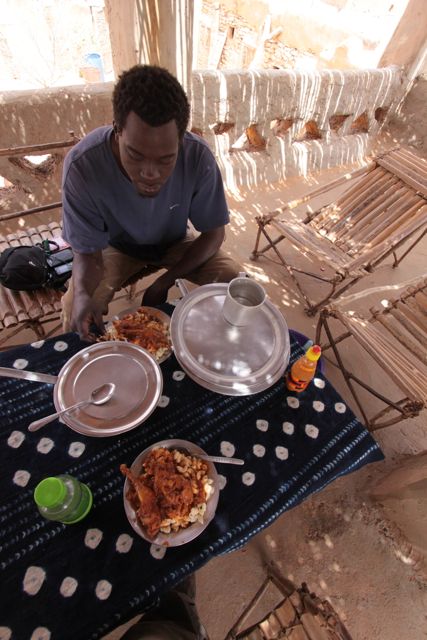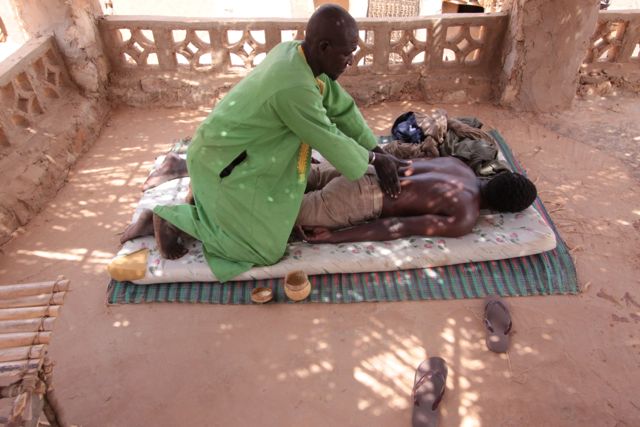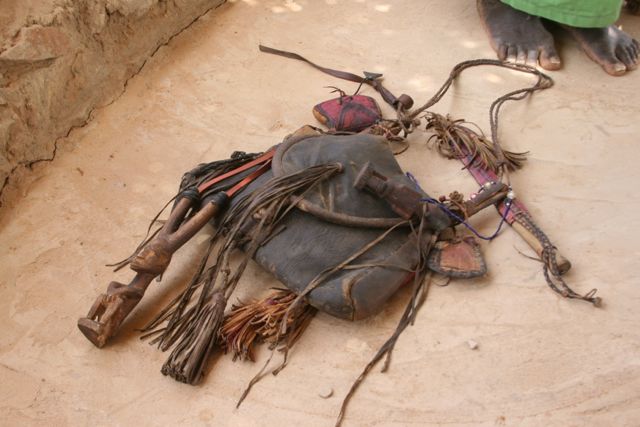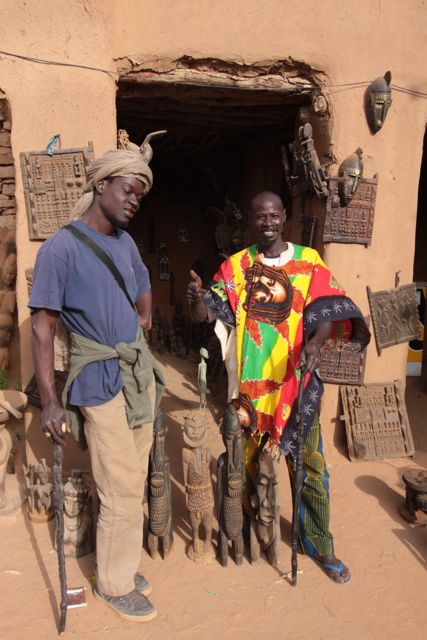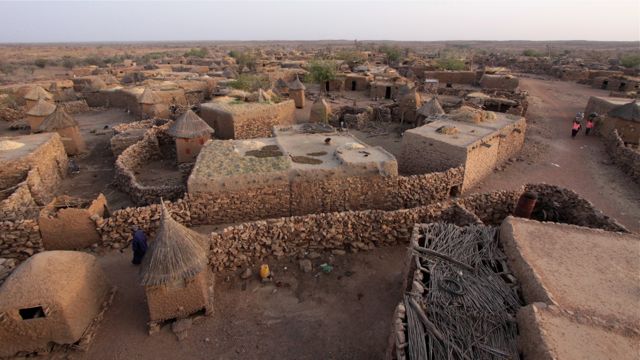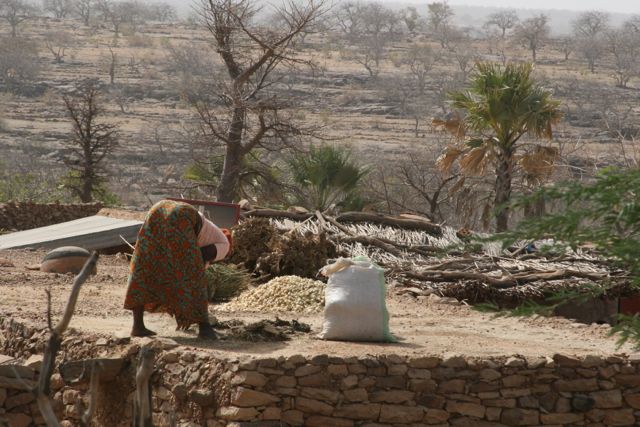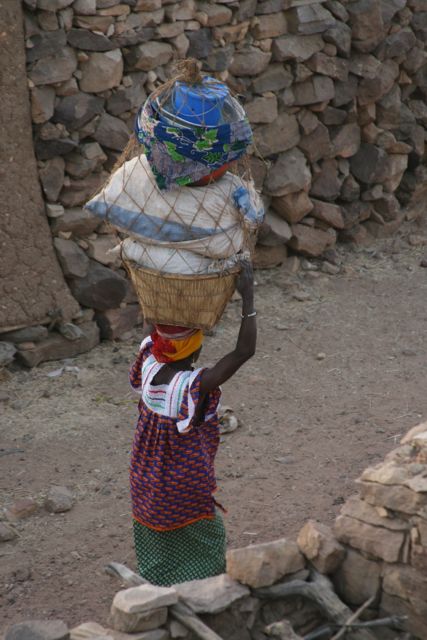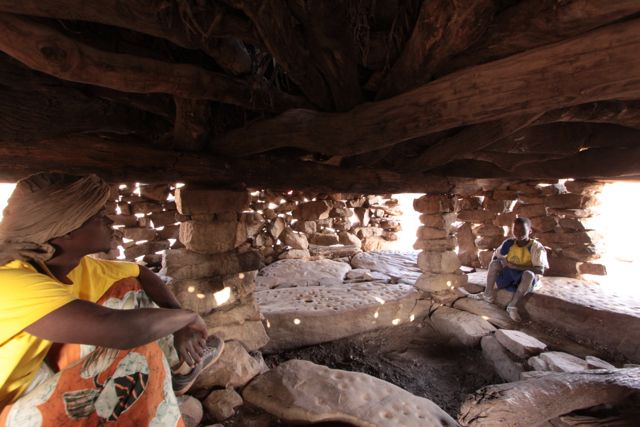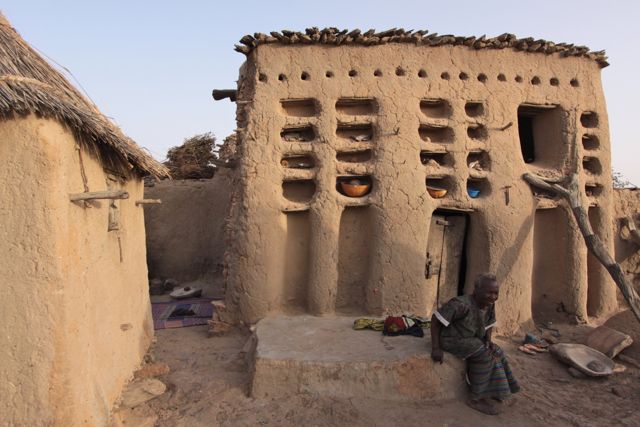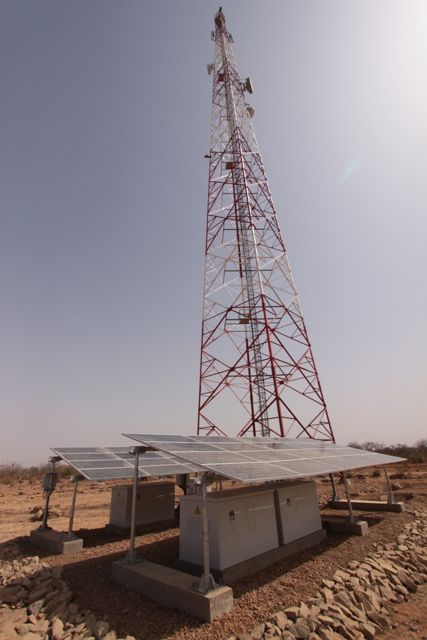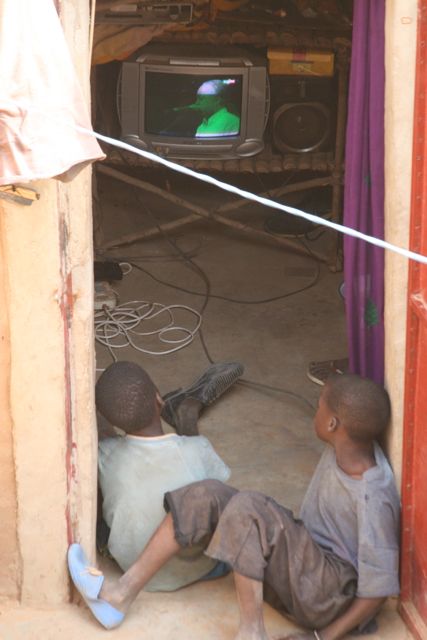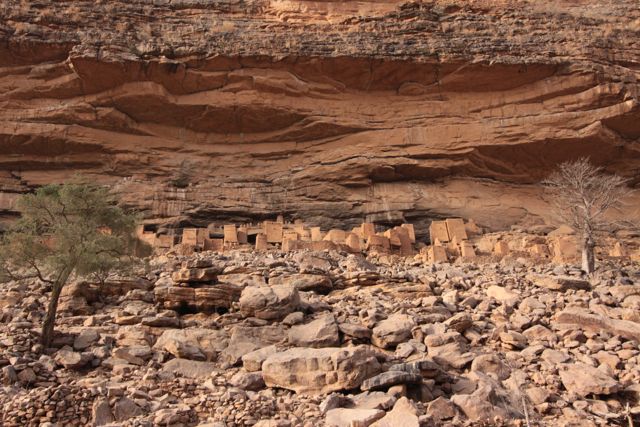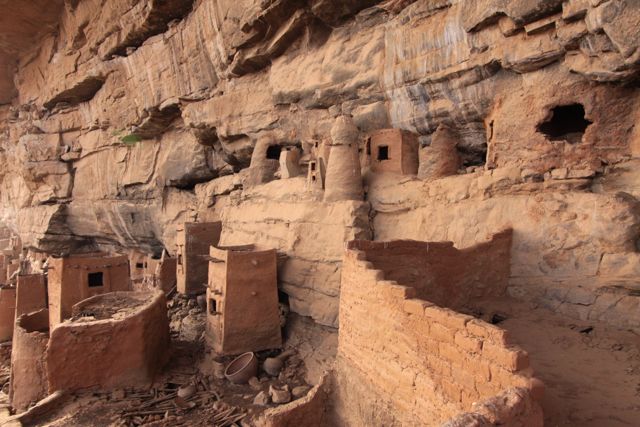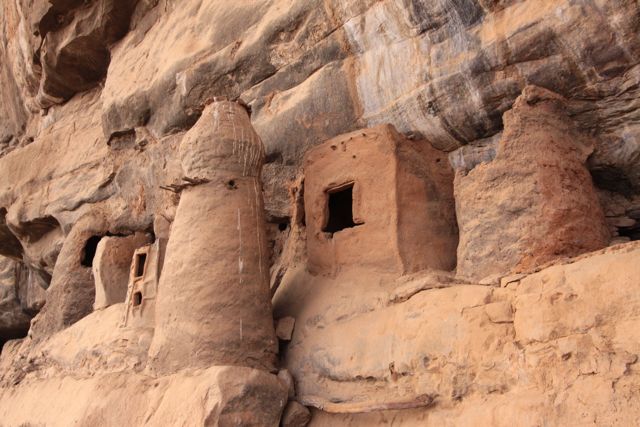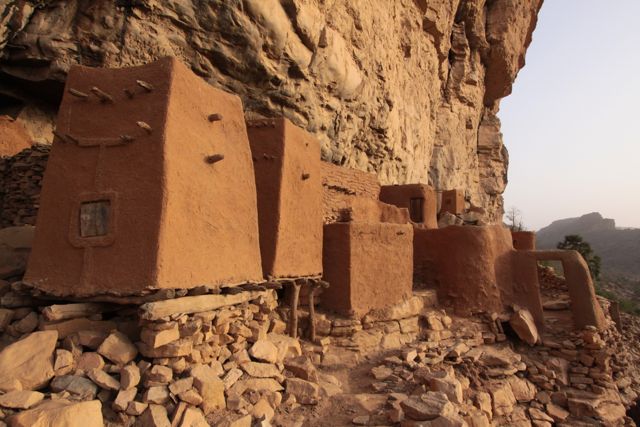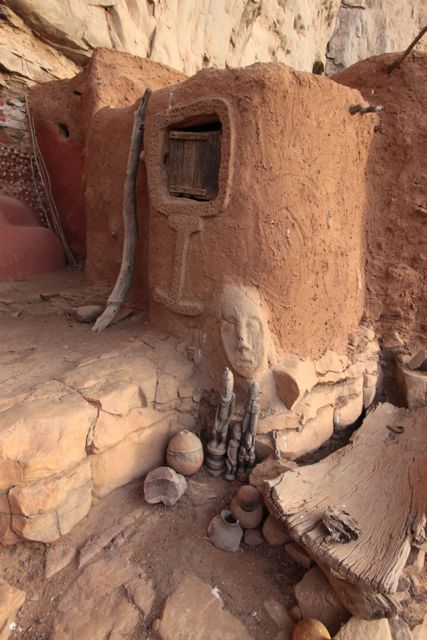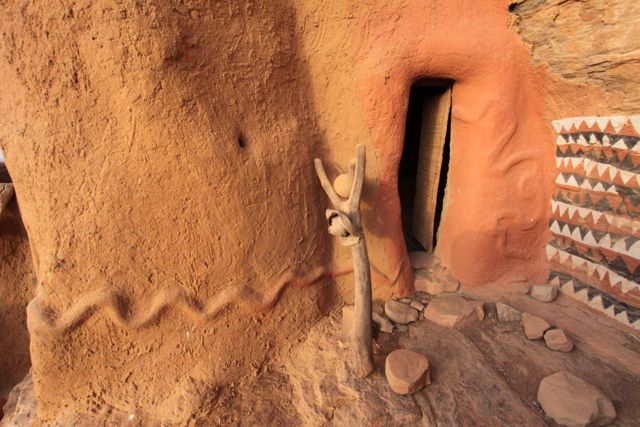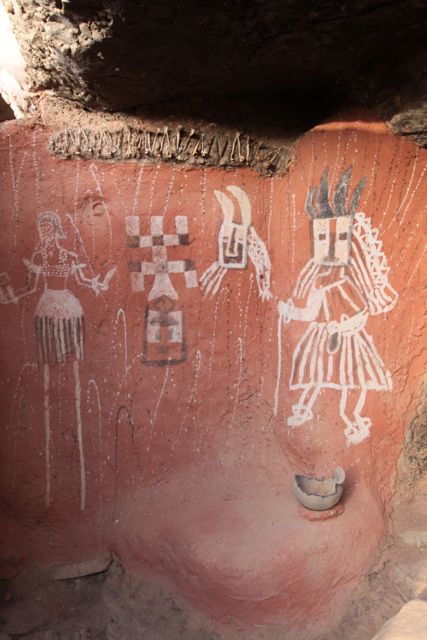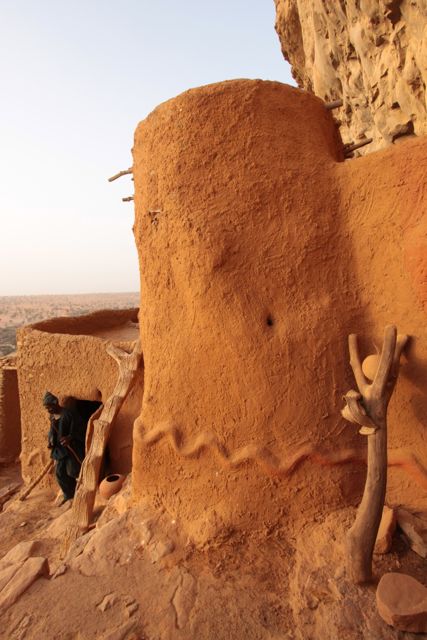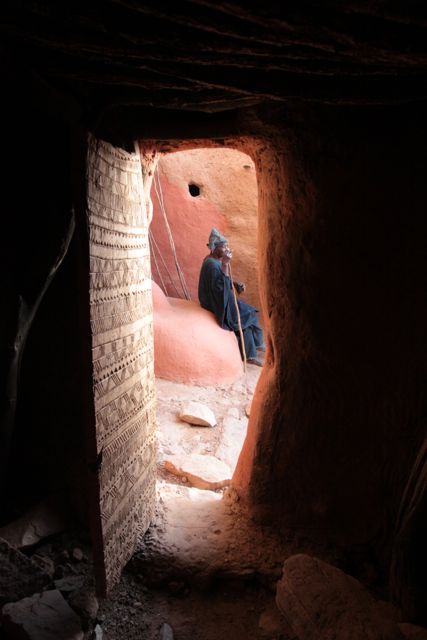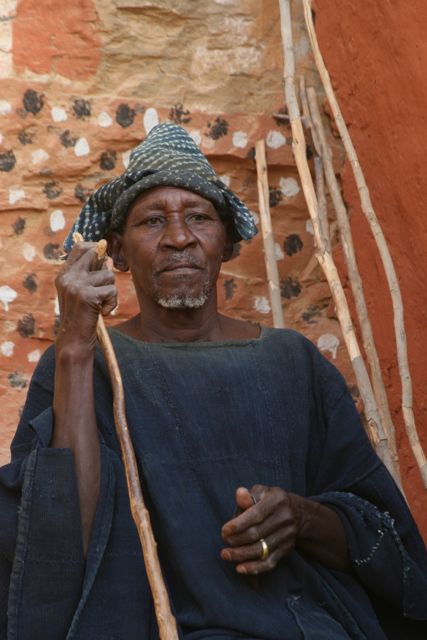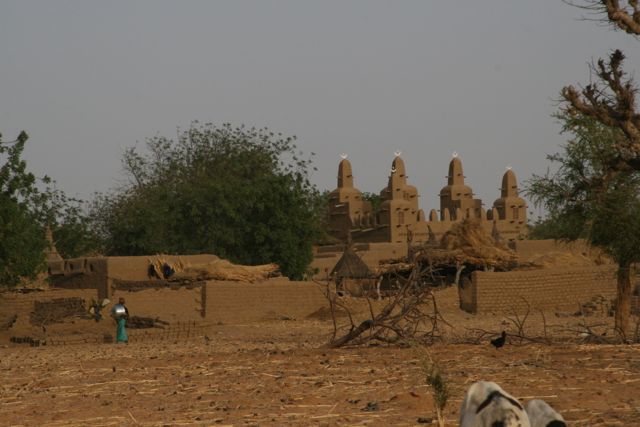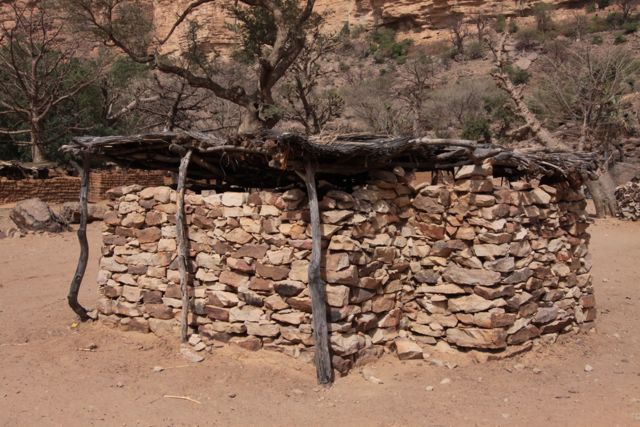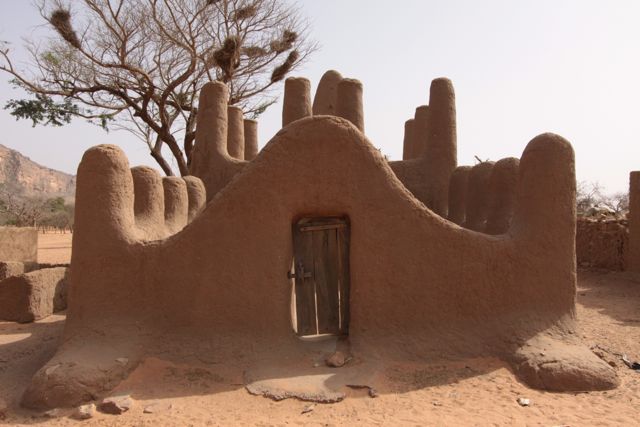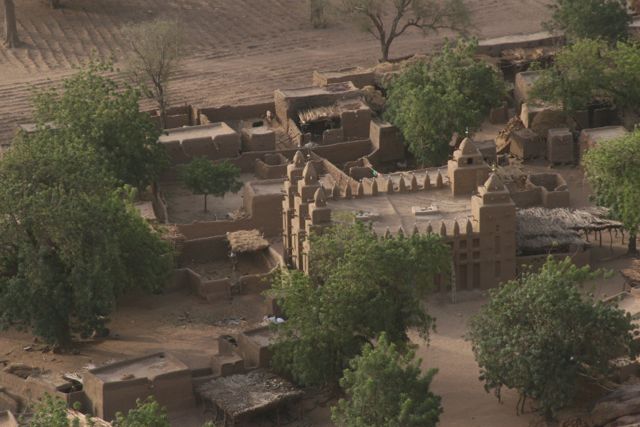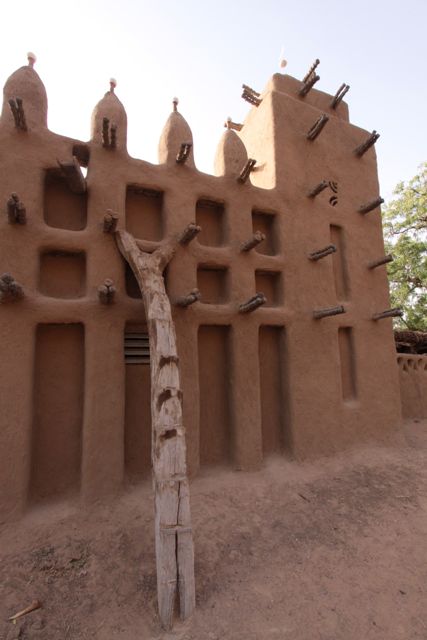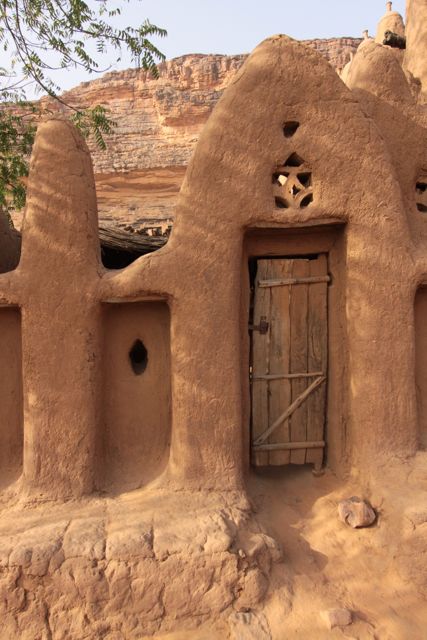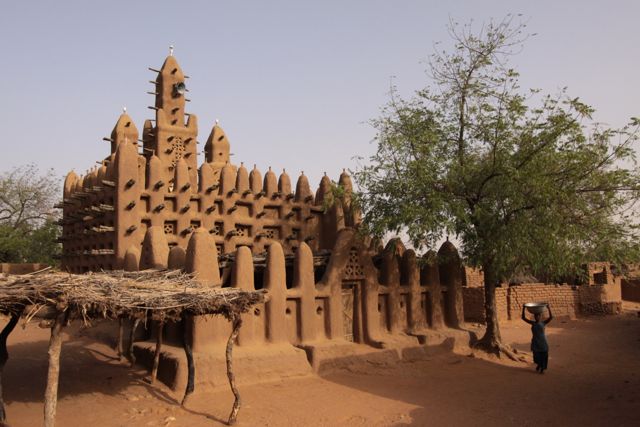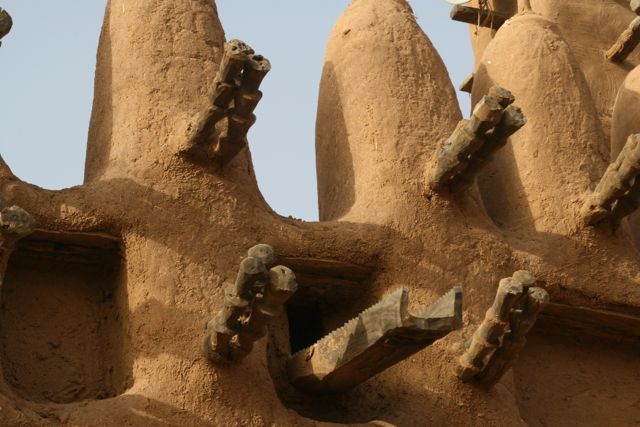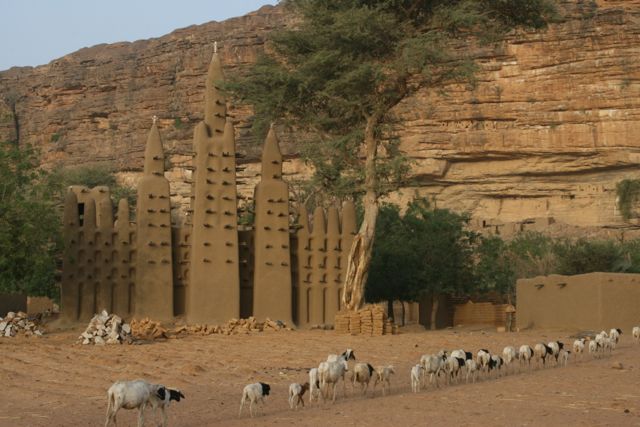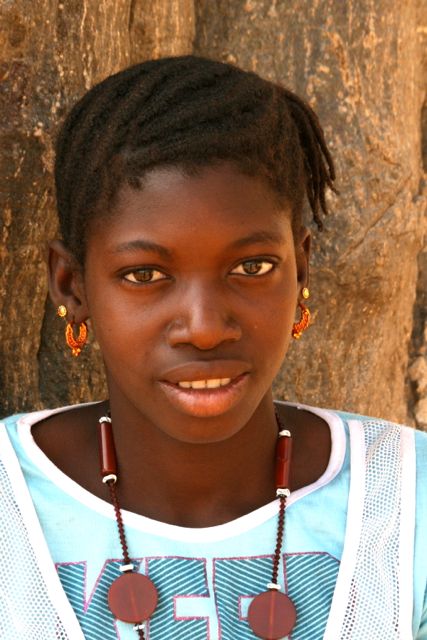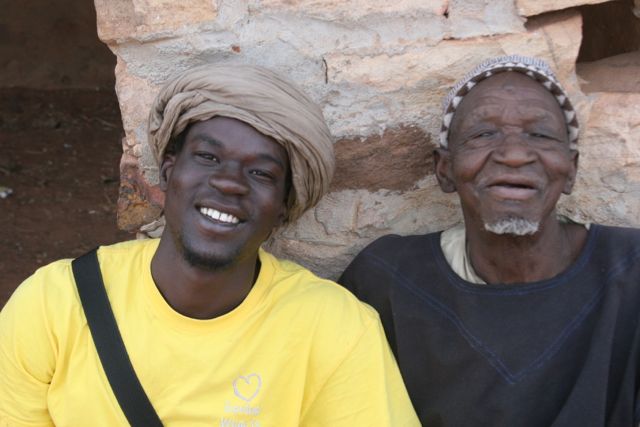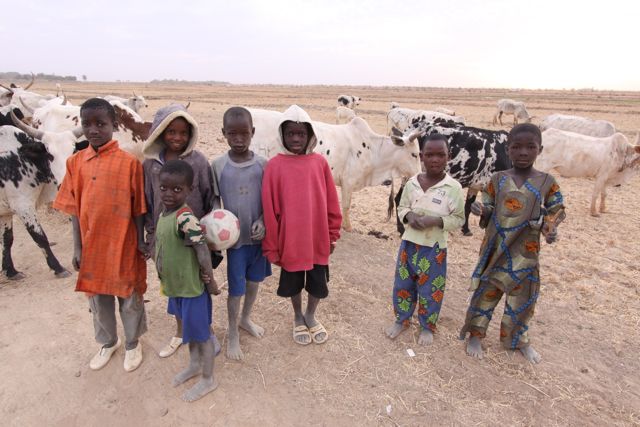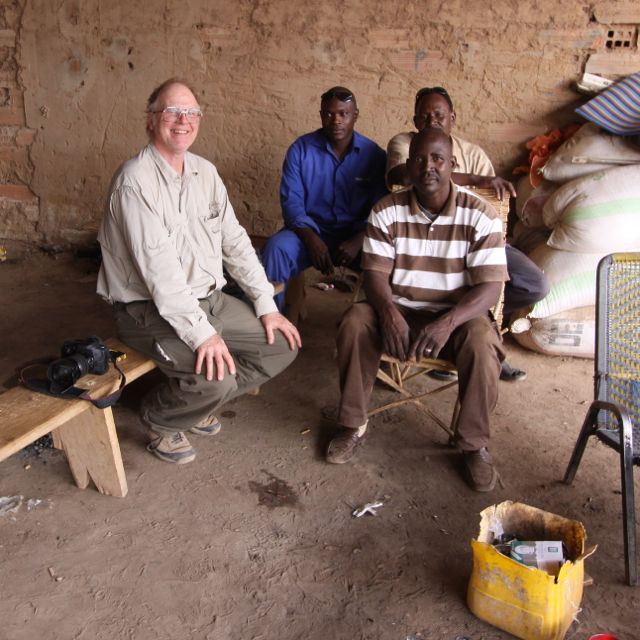Well, dear viewer, you have been a trooper...but soldier on, there is only one more place to go....
...the ancestral area of the Dogon. Merits even a map.
And some directional signs. And even some assistance from USAID.
From the banks of the Niger, the road to the Dogon is a gentle rise over bare rock.
Topping out at red earth and roads those trucks can really move on.
The Big City is Bandigahara, population of some 6800 or so. And the Big Driver of the economy is tourism. So, let's build a tower to welcome them to town!
Or, better yet, a place to serve them espresso!!
Not quite like the espressos, or baristas, of Seattle, but its the journey not the destination.
We drove on, until the road ended at "la falaise", the escarpment, the cliff.
The Dogon live in villages on top of the escarpment or...
...at its base.
We started at the top, and started a routine which we would follow for the next five days. Upon arriving at a village around 11:00, we would order lunch. Looks like we had chicken, and the rooster beyond escaped to live another day.
Then it was xiuxi, siesta, nap time. Well at least for Ibrahim....
...more likely time to explore local housing types for me.
And of course their doors.
Or maybe look over the ever present carvings for sale.
Once the sun began to get down (if not the temperatures....high 90's or more) we would "take a tour" of the village.
These are two granaries recently built and given new thatched "hats".
Here is one being built. Apparently thick adobe walls do not work; these are built with hand-patted lifts about 12" high. Allow to dry the night and then repeat. Poles are inserted to hold shelves upon which jars or baskets of food stuffs will be stored.
When completed, small doors allow access to the interior, and the roof rafter tails a place to hang bags for fermenting millet beer and ears of corn.
When we came across some work in progress we would duck in. The child operates a hand cranked blower for the fire, while his father heats rods with which to make holes for bolts or nails.
When time allows, he also carves handles, statues, doors, canes, etc for domestic use and tourist souvenirs.
Then it was time to set out on the road, or in this case, trail, to the next village for the night.
Sometimes we would come across fields of greens, located near a source of water.
A source which took some effort to get down to.
A falaise top village, with stones all around so stone walls for the houses. Organic architecture on steroids.
Encampments are a dispersed building affairs: the kitchen is spread out over the courtyard; the toilet and showers are at the edge of the cliff (the tank, with the colors of Mali's flag, might work better for water heating if black, but then, when its sunny all day, probably makes no never mind).
Inside one of the guest rooms, decorated with paintings on the wall, a bed with mosquito net. Expectation dashed: laden with bug spray and net and "insect shield" clothing, I saw only one or two mosquitos the whole time ... but it was the end of the dry season, things might be different in the rainy season.
The dining room was over in a courtyard corner, up against stone walls, among the soda pop containers and conveniently located near the trinket sales.
And of course tea was a constantly being poured: morning, noon and night.
The Dogon are well known for their fierce retention of their animist beliefs in face of Islamic and Christian intrusions. Careful walking is required, one might inadvertently trample a fetish.
Though intruding, Islam is a widely held faith among the Dogon.
As is Christianity. Hey, might as well cover all your bases.
Our route took us down the falaise, ...
...to the sahel below: the zone between the Sahara Desert in the north and the savannas in the south. Trees of varying sparseness in the barren semi-arid fields, which will be planted and sowed during the brief rainy season.
An event beyond imagination when walking these roads in 110 degree weather under cloudless skies. Do note the two women who are carrying babies.
An event beyond imagination when walking these roads in 110 degree weather under cloudless skies. Do note the two women who are carrying babies.
Walking these paths and roads we passed people pursuing their livelihoods. Baskets!
Woven from the straws of grains grown during that brief rainy season.
Hmmm, how does one get this to and on the airplane....
Or weavers, using threads of cotton grown in Mali, but more likely shipped to Morocco for processing and shipped back for use.
A very simple two heddle back-strapped loom, weaving 6" wide and forever long bands of cloth.
The women, using a mud-resist technique, create blue and white designs, then stitch the strips together for wide bolts of cloth.
Gourds, made into small lidded containers, are hawked by this child, on watch for passing tourists. How can one resist? and it fits on the airplane to boot.
In northern Mali, in the Sahara desert, camels are common. Not so here, this the only one we saw.
More common are modern youths and their Chinese motorcycles. And they think Malians are ready for Sharia Law?
And of course the women bear the brunt of the work. Trekking up the falaise in the early morning, scavenging for firewood, and walking back down to their villages. If you count three babies I think you are correct.
Often a village would be heralded by a well, undoubtably dug and cased with assistance from some foreign agency. Here the boys and men pull up water to fill jugs to take to town, and troughs for their cattle to drink now.
Pulling into an encampment, for lunch, or for dinner and the night was always a welcome event. Note the solar PV panel recharging a car battery.
Encampments were invariably decorated with statuary, especially voluptuous women breast feeding their babies.
Water, being precious, is used and re-used: note the basin's drain line waters the flowering plant.
From roof tops I could peer over and watch the meal preparations. In the kitchen, in the farm yards, in the fields, work at ground level was done bending from the waist with locked knees.
Of course pounding grain of is done standing.
Once ready, meals are always eaten "al la fresco", in the dappled shade of woven mat roofing.
After lunch, a massage from a passing medicine man was bliss.
And his bag a riot of fetishes, creams and whatnot. Not so precious that a sale couldn't be negotiated: the little statue on its stomach in the upper right corner of the bag now hangs from by day-pack.
This is where I made my Big Purchases: the two canes being held by Ibrahim and the shop owner, and two small granary doors, similar to those on the wall behind. Bob Marley is BIG in Mali. I think the fundamentalists from the North will have difficulty imposing Sharia Law on the Malians....
The Dogon trek ended at Ibramim's home village. His uncle runs an encampment from which I sat and watched sunrise, and daily life getting started.
Tending onions drying on the roof,
Departing with onions for town market town some miles away.
Meanwhile we walked about looking at village architecture: a "tounga", where elders meet to discuss important issues, or just the news of the day. When not being used by them, kids and tourists can crawl inside to get out of the sun.
Or a residence, whose front wall has niches for daily utensils and of course fetishes.
On the edge of town, a new Chinese built PV powered cell and microwave tower provides cell phone service...
...and roof top dishes capture satellite TV.
One of the prime attractions in the Dogon area are the remains of previous settlements.
Not only Dogon, but those of an earlier peoples, the Tellem, as well.
The Tellem must have been short, these upper structures are incredibly small.
The lower ones are Dogon, many of which have been recently restored for the tourists benefit. This complex is the "home" of the Hogon, or spiritual leader, of the village.
We arrived just after sunrise, no one was home, so we poked about looking outside and in, being careful not to disturb anything or any fetishes.
From the fresh parging on the walls and bright colors, we could tell it is well preserved.
Not only fresh paintings, but fresh wishbones, stuck in mud, from sacrificial chickens.
When we came out from exploring inner rooms and courtyards the, Hogon was now in: he had walked up from the village, changed his clothing, and was ready for work.
Sitting on his seat, which we had been careful not to touch...bad luck, ...
...and posing for tourists' cameras. We left a gratuity at the right spot and bid him "Au revoir".
And of course we looked over mosques as well. Sometimes from afar...
...but more often we would go up to them for closer look. This is the smallest and simplest we saw: part of a weekly market place so vendors and shoppers alike have a handy place for daily prayers.
Not much larger, but in the plastered adobe style, is this neighborhood mosque. This is the woman's entry to their courtyard behind the enclosed space, into which the men's door directly enters.
Some of the villages' Friday Mosques are rather grand...reflecting the style epitomized in D'jenne's.
A typical ladder with which to access the roof.
As in D'jenne the walls need re-coating to protect them from the rain...
...so scaffold supports are permanent fixtures on the walls, as are scuppers through the parapets. After days of travel in Mali under cloudless skies, it is hard to imagine water pouring off the roof.
Like the sheep headed off to other destinations, I too had to say "Au revoir" to Mali. But, although all the things, and buildings and landscapes I saw were amazing, it was the people who are extraordinary, such as ....
....this girl we encountered along the road....
...and my guide Ibrahim and his uncle.
I know I am supposed to end with a dramatic sunrise or sunset photo, but, in light of Mali's current troubled times, I use this one of boys near David's agricultural project...shooing cattle and booting a football...to again urge you to visit OXFAM's Mali page (http://www.oxfam.org/en/development/mali) and donate to support their relief work there.
